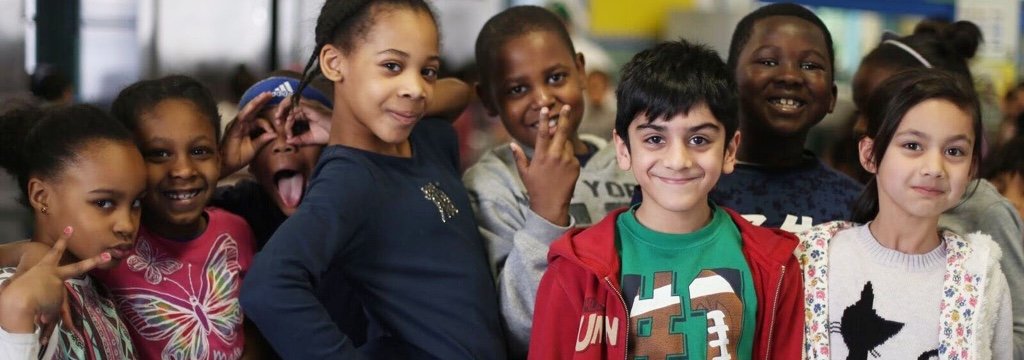Get more from InsideSchools
PS19 East Village Community School
Share this school
Manhattan NY 10003
Our Insights
What’s Special
Joyful, progressive school; extra recess and plenty of field trips
At PS 19/East Village Community School, a school-wide morning meeting begins with a few dads, moms and teachers strumming banjos and guitars leading an audience sing-along of "This Land is Your Land." It's a family affair, with long-haired dads bouncing infants; toddlers clapping along with the kids on the stage; and one tyke even crying inconsolably after the show ended because he wanted to stay at school with his older sibling.
"This is my favorite time of the month," said a pre-k dad at this progressive East Village school. "We get to sing all these old songs. The principal is doing a great job of bringing all the kids together and it starts with the morning meeting."
At the start of the 2022-23 school year, East Village Community School officially merged with PS 19. The newly combined school is located in the PS 19 building and led by East Village Community Schools longtime principal, Bradley Goodman. Prior to becoming principal in 2014, Goodman worked as an assistant principal and also taught at the school for several years.
EVCS can seem almost like a throwback to the 1960's, even down to the singing of the 1972 song "Free to Be You and Me." Kindergarten still looks like kindergartens of old, where children learn through play to read, write and get along with one another. The block corner doesn't disappear after pre-k - it's an active place used even in 1st grade lessons about community buildings.
During his tenure, Goodman has pumped up the responsive classroom method as a technique that "sets a positive tone." Every class starts the day with a meeting - a ritualized share, and activity. "Students acknowledge one another, make eye contact and say kind words," he said. Certain hand signals and a chime show students it's time to pay attention, move to a different activity or request permission to use the bathroom.
There is joy in the classrooms, and plenty of exploration. Each class goes on as many as 10 fields trips a year, not counting the many neighborhood walks. Pre-kindergartners consider the question: "Where does food come from?" and then visit the Union Square Farmers Market. Even the youngest children help plan what they are going to do or study.
Art, music and social studies lessons frequently are intertwined. The kindergarten adopted a special elm tree in nearby Tompkins Square Park in their study of trees. As part of a Lenape Indian study, 2nd-graders built longhouses and created a mural about Lenape Indians; 3rd graders studying China created costumes and performed a dragon dance.
The atmosphere is informal: teachers and administrators go by their first names and students may pull out snacks if they're hungry. Freedom does not lead to chaos, however: classrooms are tidy and all items, from books to blocks, have clearly defined homes in color-coded bins and on brightly labeled shelves.
Homework isn't assigned until 2nd grade and there are no consequences for not doing it. "We don't get too freaked out about homework," said Goodman, himself the parent of two young children.
Teachers do lots of pre-assessments to determine how children are doing, said Goodman, which "allows us to tailor instruction to a wide range of learners."
There's a fulltime math coach. Kids are taught to understand the reasoning behind math problems and there is a balance between conceptual learning and memorization of facts such as multiplication tables.
Children arrive as early as 8 am for a half hour of supervised play before school starts at 8:30 and every child gets 25 minutes for outdoor play at daily lunchtime recess. Older kids spend 1.5 hours a week in electives such as a rock band, drama, martial arts or chess.
Special education: There is an ICT class on each grade and an inclusive atmosphere throughout the classrooms.
Admissions: District 1 lottery. (Pamela Wheaton, December 2015; updated September 2022 with school merger information)
Read moreSchool Stats
Is this school safe and well-run?
From the 2024-2025 NYC School Survey
From this school's most recent Quality Review Report
From the 2023-24 School Quality Report
How do students perform academically?
From the New York State 2023-2024 Assessment Database
What is the Pre-K like?
From the NYC Program Assessment (CLASS and ECERS-R) Database through 2019-2020
Who does this school serve?
From the 2024-25 Demographic Snapshot
From the 2023-24 School Quality Guide
From the 2020 School Directories
How does this school serve special populations?
From the New York State 2023-2024 Assessment Database
Contact & Location
Location
Contact
Other Details
Was this information helpful?
Get more from InsideSchools
You may also like …
P.S. 40 Augustus Saint-Gaudens
Manhattan, NY 10003
Success Academy Union Square Charter School
Manhattan, NY 10003

Comments